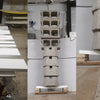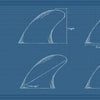Stringerless constructions testing

Developing my surfboard design and constructions mainly for freshwater river surf spots that are mostly soft, I had to get the maximum flotation and a lively feeling to get the maximum of those waves. It made also sense to try to use the best environmentally friendly products like EPS and Epoxy.
Stringerless EPS/Epoxy boards are generally lighter surfboards that float more than regular PU boards. Their weight distribution also makes them pivot more because the swing weight of the nose is less. Furthermore, they flex more and bounce back the energy to help generate speed.
Board building is all about feeling, so it’s hard to put numbers on feelings, but I felt that I wanted to know more about how resistant and flexible different constructions could be, so I decided to do some mad science and did some testing.
I cut 6 pieces of 2 pounds EPS with the same dimensions and glassed them with different constructions with the same glassing schedule I usually use.
All samples are glass using the same technique with Entropy Bio base Resin for surfboards and JPS Composite fiberglass.
- 2 layers of 4oz E-glass on top and 1 layer of 4oz E-glass on bottom.
- 2 layers of 4oz S-glass on top and 1 layer of 4oz S-glass on bottom.
- 2 layers of 4oz S-glass + (1x) 3/4wide spread tow carbon tape on top and 1 layer of 4oz S-glass + (1x) 3/4wide spread tow carbon tape on bottom.
- 2 layers of 4oz S-glass + (1x) 3/4wide spread tow carbon tape on top and 1 layer of 4oz S-glass + (1x) 3/4wide spread tow carbon tape on bottom. (Resin use with 4% pigment)
- 2 layers of 4oz S-glass + (1x) 6 Strand Carbon Hybrid 80mm on top and 1 layer of 4oz S-glass + (1x) 6 Strand Carbon Hybrid 80mm on bottom.
- Special Alchimie construction, Info will come in future posts, but I’ll give you a glimpse of it.

Sample are 1-3/4 ‘’ thick.
I measure the flexion of each construction until rupture.
The bounding with the epoxy on the EPS was incredibly strong and did not delaminate in any sample. All samples ended up breaking on the top where the force was in compression on the foam even if there were 2 layers on top.
Measurements were taken with a rule, so accuracy is +-1mm (max).
See result:

S-Glass vs E-Glass
One of the main goals of this test was to view the strength of an S-Glass construction vs a regular E-Glass construction on an EPS sandwich construction. While the S-Glass is said to be 30% stronger in tension and 10% stiffer, the fact that that construction broke from the compression for the foam, there is no advantage for the S-Glass in this particular test. I wanted to add that I still believe there is an advantage of using S-Glass for board durability and strength in some construction, but in those tests, it made absolutely no noticeable differences.

Fiberglass only vs Carbone sandwich construction
Samples 3 and 4 were the same construction but sample 4 had resin tint.
Those two samples were really close to one another, and we believe that the pigment had little or no effect on the strength of those samples.
They were both with the spread tow carbon tape which does not add any fiberglass to the construction compared with the hybrid carbon tape of sample 5.
On sample 5, adding hybrid (fiberglass and carbon tape) improves the resistance of the sample, but it also stiffens it more than with the spread tow tape and added more weights.

Alchimie Construction
We were particularly happy with the result of our new construction which is flexible and strong.
It resisted more than 300 pounds, which is way more than what we could imagine!
This construction will be on test in some of our prototypes this year and we are excited to keep you updated with those tests. Stay updated by following us on Instagram to know more about this new construction.

Conclusion
Those tests were a long and precise process, but we have a better understanding of our materials and the way they react to flexion, this will help us (and hopefully more people) develop products that will be different and will create a lot of smiles in the lineup!




